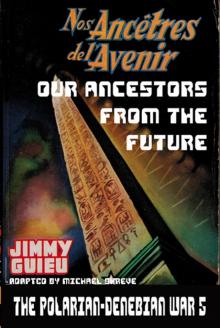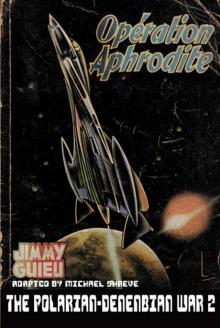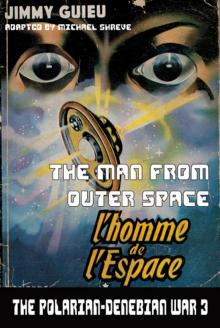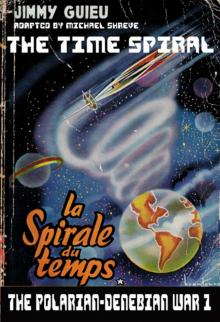- Home
- Jimmy Guieu
Polarian-Denebian War 2: Operation Aphrodite Page 2
Polarian-Denebian War 2: Operation Aphrodite Read online
Page 2
At the moment when the spaceship was flying over a crater radiating a series of fissures and crevasses like so many others, Lieutenant Clark shouted out in a real exclamation of surprise, “A light! I just saw a light, some shade of purple, blinking inside that crater there to our left…”
Professor Harrington and the others scrutinized the screen where he was pointing but saw nothing out of the ordinary. Their flight, moreover, had already carried them beyond the bulging ring.
“You were dreaming, Lieutenant. That crater, called Aristarchus, looks absolutely normal just like all the others.”
“But I’m sure I…”
“Tiny motes in the eye sometimes play strange tricks, Lieutenant Clark,” Streiler added.
Rudy Clark frowned skeptically and shrugged his shoulders. Then he turned and went to join his men to tell them the latest orders. “Motes in the eye!” he mocked under his breath.
With its bottom toward the surface, the rocket descended on a column of burning but invisible gas in the absence of an atmosphere. It set down gently just beyond the Kepler crater whose serrated edges stood just over half a mile from the ship.
Harrington and Streiler shut off the distributor pumps. The screen showed a gloomy moonscape outside, whitish, half-veiled by a cloud of chalky dust (kicked up by the gas emissions of the jets), a dust that slowly floated straight back down without swirling around like it does in our atmosphere.
Seeing this corpse of a star, desolate, arid and plunged in eternal silence, the astronauts felt a kind of oppression in their spacesuits, like an almost superstitious dread.
Harrington, also feeling uncomfortable cleared his throat as if he was afraid to speaking without this polite warning and all he could stammer out was, “Well, uh… We… We’re here on the ‘poetic’ Phoebe.”
CHAPTER TWO
With Professor Harrington’s nod of agreement, Kariven sat in front of the powerful two-way radio specially built to communicate with Earth on a precise wavelength. He turned it on, adjusted a dial very slowly, manipulated some other controls and waited. After a few seconds a red light started blinking, casting a rhythmical purplish flash.
“Rats and Mice here,” he announced in code. “We’re in the cheese…”
Around three seconds later—the delay it took the hertzian waves from the Moon to reach Earth and return—the response came back, weak but audible. Gathered around Kariven, silent and attentive, the astronauts listened to the voice coming nearly 240,000 miles through the abyss of space.
“Message received. Cat number 17 here. Turn up your power, Rats and Mice… I’m barely hearing you…”
Kariven delicately adjusted two calibrated dials and tried again, “Rats and Mice to Cat 17, can you connect us to the Big Tomcat?”
Streiler turned on a wall screen showing, in rear projection, an earth map with numbered red circles at different points. “Cat 17,” he explained, “is a mobile station set up on a US Navy destroyer off the coast of Dakar.”
The speaker crackled and the mobile station answered, “Cat 17 to Rats and Mice. Big Tomcat is informed. Stay on this frequency and wait for his call. We’ll put him through. Over and out.”
In the vast underground headquarters of White Sands, General Miller—i.e. Big Tomcat in the code—had just received the message relayed by the destroyer off the African coast. The terrestrial hemisphere presently visible from the Moon covered Africa and part of Europe surrounded by fog. Direct radio transmission between the Moon and the USA, therefore, would not be possible until the Earth turned its lighted hemisphere of the Americas to the Moon. They would have to wait at least five hours for the Earth’s rotation to bring the American continent in the right conjunction with the Moon, making direct communication possible between the rocket and White Sands.
In the huge underground HQ cluttered with seven rows of giant, electronic, computing machines, General Miller sat in front of a two-way radio. After tuning the controls to the correct wavelength, he plugged in the relay and sent his message to the American destroyer that would in turn send it on to the astronauts waiting near the Kepler crater.
“Big Tomcat to Rats and Mice,” General Miller began slowly, “I’m glad to hear that you’ve reached the cheese without a hitch. Congratulations.”
A few seconds later Kariven’s voice echoed in the HQ speakers, “Rats and Mice to Big Tomcat. We’re going to start nibbling the cheese right away. We’ll transmit in two hours, unless there’s an emergency. The tape recorder will stay on in case you have orders to give us in the meantime. You can ‘pet Mickey’ anytime. Over and out.”
“Big Tomcat to Rats and Mice. Message received. We’ll pet Mickey at the appointed time. Good luck. Over and out.”
Kariven turned on the tape recorder, which would automatically record a message if a call came in from Earth.
“I believe we can leave now, my friends. Mickey, the cargo rocket with our supplies, will take off from White Sands tomorrow morning. We’ll get it in 53 hours.”
Ivanovitch stood in front of the armored door, hesitant and very worried. He held two sheets of paper typed in the Russian alphabet. Finally he decided to press the metal button embedded in the doorframe. A plate next to it slid open, revealing a camera lens at the same time as a spotlight shined on the visitor from head to toe.
A minute later the armored door slid silently into the wall. Ivanovitch entered the office of General Gorochenko, Commander in Chief of the Soviet Armed Forces, and he stopped six feet away from the desk, clicked his heels together and stood stiffly at attention.
Curious, the general looked up and grumbled, “What is it, Ivanovitch? I don’t like to be disturbed.”
“Excuse me, General, but considering the importance of the documents…”
“Don’t waste time with empty words. Get to the point.”
Ivanovitch took two steps forward, put the papers on the general’s desk and after stepping back clicked his heels again and went back to his steel pole position. “The cipher office just sent me this message captured by one of our radio-detection ships disguised as an Arab fishing boat in the Red Sea.”
The general glanced at the text, reread it, and looked up. “Well? Is this the first time that American agents have infiltrated us? This is a matter for the counter-espionage unit. You don’t want me, by God, to track them myself!”
“It’s that, General… uh… the responses of these two individuals are all coming at three second intervals between each other.”
General Gorochenko flinched and furrowed his brow. “How did you come to notice this… apparently insignificant detail?”
Ivanovitch’s face turned red, “It’s not me who noticed it, General. At the same time as this message we received a telephone call from the Ziolkowski Institute… The research center for long range radio transmissions also intercepted this message and the interval in question intrigued Professor Fritz Meyer… who alerted us immediately.”
The general snatched up the telephone and called the Ziolkowski Institute. “General Gorochenko here. Get me Professor Fritz Meyer. Hello… Herr Professor Fritz Meyer? What’s this story about an intercepted message and why are you so interested in the pauses between responses? Are you doing counter-espionage work now?”
“Nein, Herr General. It’s only by chance that we intercepted this message on a very unusual wavelength… The message by itself,” explained the German scientist who had been “retrieved” by the Russian after the defeat of the Third Reich, “doesn’t interest us at all and there’s doesn’t seem to be any spying scheme in it. I simply wanted to draw your attention to these intervals—unique since the invention of the radio—recorded during this strange conversation.”
“Have you been able to locate the two transmissions? And what’s so important about these intervals?”
“One of the transmissions is apparently coming from a ship in the Atlantic. In the text its code name is Big Tomcat. As for the other, we have no idea about its location because…”
>
“And the intervals, Herr Professor?” General Gorochenko barked. “What’s so unusual? Do you always just babble on endlessly on the telephone? No. Why would it be any different on the radio?”
“The intervals, Herr General,” Professor Fritz Meyer answered calmly, “simply prove that the code name Rats and Mice was not transmitting from Earth… where the transmission of hertzian waves is, so to speak, instantaneous.”
With their helmets hermetically sealed on the big, airtight collars, the American astronauts were huddled together at the foot of their rocket. Standing 20 yards away from a tiny crater only 40 feet in diameter, the rocket cast a huge shadow on the white lunar soil. As far as the eye could see were craters and mounds, lined up in the blinding light.
A strange spectacle and a terribly impressive one of this dead star flooded with the rays of the sun, that fiery orb shining brightly in the black, starry sky. The absence of atmosphere did, in fact, make it possible to see clearly both the sun—the fantastic blinding globe—and the countless constellations. Mars almost reaching its perigee12, glowing red, looked like a disc the size of a gold coin. The Earth, on the other hand, a huge, greenish ball suspended in the black of space, had a diameter four times bigger than that of the sun.
Professor Harrington’s voice echoed in the helmets linked together by tiny two-way radios. “We’ll examine this dwarf crater. It might be perfect for the temporary installation of the Bubble Base.”
While some of the team unloaded the equipment, the others started off. Their big strides on this star whose gravity was only one sixth of the Earth’s made them jump 10 or 12 feet high. That was why our astronauts were forced to walk slowly. Their boots sank up to their ankles, sometimes up to their calves, in the thick layer of powdery soil. The chalky dust, white or yellow depending on the spot, drizzled back down in their wake, into the depressions left by their heavy boots.
Climbing up the 10-foot high crater required no effort. They stopped for a moment to contemplate the basin, then jumped with their feet together. Slowly tracing a 15-foot arc, they dropped onto another thick layer of the chalky dust or ash, the “earth” of the Moon.
Streiler, who had miscalculated his leap, fooled by the difference in gravity, somersaulted and bounced (no injuries sustained) onto a small hump in the middle of the crater. Having hit the ground twice, once with his helmet and then with a foot, two clouds of dust were kicked up. Now they were falling back down in weird slow motion like a floating feather and, as always, without swirling.
When he rejoined his friends, Kariven joked, “So, Kurt, you’re playing the clown?”
The engineer laughed and gave him a friendly little poke in the side of his spacesuit, which sent the doctor into the dust.
Professor Harrington was squatting down and digging his gloves into the layer of dust. He did the same all around the perimeter of the crater, stopping every six feet to probe the ashy bed.
“This layer of ‘seleno-cosmic’ dust is around eight inches thick on average,” he stated. “The powdery material is like volcanic ash. It’s basically a bunch of fine, meteorite grains rained down from space for millions of years. We’ll have to empty this crater of all the dust to be able to dig the foundation for our base.”
“A long and tedious work that will make us lose precious time,” Commander Taylor remarked. “Coming over the crest of the crater I noticed a long crevasse, 10 to 25 feet wide in places but it didn’t look too deep. Maybe we could take a look before starting this grunt work.”
“OK,” Streiler agreed after discussing the possible usefulness of the crevasse with Professor Harrington. “We obviously have little chance of finding a cave in this dead world that suffers no erosion. Let’s go.”
The crevasse spotted by Commander Taylor stretch out as far as the eye could see, winding out from the base of the half-mile wide crater. It was not, strictly speaking, a crevasse but rather a “fissure,” an extension of a crack opening onto the edge of the crater and widening out in the distance with angular twists and turns.
Indeed, the fissure was no more than 15 feet deep where it met the outer wall of the crater. Around 300 feet away it already dropped to 35 feet and widened out to 40 feet.
“That’s what I was hoping to find!” Commander Taylor pointed to the bottom of the fissure.
At the base of the wall to the right was a 12-foot high hollow that dug into the rock at least 20 or 25 feet deep and formed a kind of natural cove.
“We’ll bring the material for our Bubble Base down here and set up in this sub-lunarian hole. Like that we’ll be protected from any eventual rock slide.”
When they got back to the spaceship the five men who had just opened an outside panel of the ship on which a winch was attached, were bringing down, one by one, the reinforced Plexiglas parts wrapped in metal strips.
When everything was unloaded, they all headed for the site chosen by Commander Taylor, each carrying one of the parts—a bulky assemblage of curved plates, 10 inches thick and weighing 250 pounds on Earth but only 50 pounds on the Moon.13
Professor Harrington hooked together the three parts of a metal ladder, slid it into the fissure and was the first to climb down. While the parts of the “bubble” base were lined up along the edge of the crevasse, he approached the small cave and turned on his Geiger-Muller counter. Holding the tube out he ran it over the natural excavation, 15 feet high by 35 feet long and 30 feet deep, but the typical blinking light did not flash on. No radioactive element, therefore, was present in the rock. If there were uranium on the Moon it was not in this area. Consequently, the base could be set up without fear of harmful radiation.
Except for one man left in the rocket whose mission was to stay in contact with the Earth, all the astronauts started working. The metal strips wrapping the Plexiglas pieces were cut and the pieces put together into a kind of elongated “ball”, hence its descriptive name Bubble Base or “Ball Base.”
Just under 15 feet high, 20 feet wide and almost 30 feet long, it took six hours of relatively easy work, thanks to the weak lunar gravity, to construct the transparent base. But it was still not finished…
Carrying a big metal tank of compressed air and armed with a spray gun, a specialist shot a sealant over the seams to reinforce the airtight plasto-mastic joints of the different pieces. With his finger on the trigger, he sprayed a thick, colorless film over the joints. This special film, in the lunar air, solidified instantly in a strong bond for the walls of the base.
They could get to the Bubble Base through two tubes, also made of reinforced Plexiglas, one at each end, around 13 feet long and 3 feet in diameter. The astronauts, therefore, had to crawl in on their bellies or at best on hands and knees. A decompression valve separated the middle of the tube from the hatch opening onto the base itself.
In order to get the equipment and limited furnishings for the expedition into the “ball”, four convex panels had been left open. When all the material was brought in, these four pieces were put back and sealed up.
By building their base in this hole the astronauts saved at least 24 hours because they did not need to dig out foundations to install it. The base was built on flooring that was also made of adjustable, super resistance material. The whole was, therefore, put on the flat ground of the cave and anchored down by steel “wedges”. After a quick snack—consisting mainly of paste or mash—the astronauts finished the most delicate part of their job: setting up the air distribution system of the sub-lunarian base.
The chemical generator producing oxygen and helium14 of the artificial atmosphere measured six feet long by five feet on each side. It also included a system of pumps that expelled the air from the “dome” where the space explorers would be living. Another machine, thankfully less bulky, would be attached to the inside of the base. Its purpose was to catch the bad air and transform it into breathable air. The two machines would function automatically by electronic adjustment either speeding up or slowing down the input and output. Finally, a t
hird machine contained the climate control for cooling the base during the lunar day and heating it up at night15.
The technicians worked through a good part of night… or rather a period of time that, given the time of their arrival on the Moon, would have represented a part of the night on Earth. When they got back to the rocket, the base was ready for a test to check its sealing, resistance and hence its livability.
After a “night” of well deserved rest, the astronauts woke up to the sound of a siren inside the ship, which rang automatically every eight hours (earth hours) as programmed by Commander Taylor.
Without any water at all—according to all information—on our satellite, what was used by the members of the expedition for showers was collected and purified to be used again.
Daisy, the first interplanetary rocket from Earth, was, therefore, a truly automated laboratory. Even the leftovers from the meals were saved. An automatic waste disposal reduced them to a pretty unappetizing mush to be used as fertilizer for the future installation of a permanent American base on the Moon. This “syrup” would be boosted with chemicals before transforming it into the real fertilizer needed for an experimental botany lab. For, such a lab would be built in order to grow, under huge Plexiglas bell jars, the necessary vegetables for future “colonists.” Hydroponic fields16 would also be built under the jar when everything was ready.
The team of technicians headed for the Bubble Base to carry out the necessary trials. Within two hours the various tests were compete: air distribution, sealing, functioning of the electric generator for lights and machines, everything was tested, re-examined, supervised and experimented on to their complete satisfaction.
“We can live in the base now,” the physicist lieutenant MacDonald said, crawling out of the decompression tube.
“Bravo!” Streiler cheered, rubbing his gloved hands together. “We’ll be able to sleep without our spacesuits tonight and not in that damned old Daisy!” Smiling under the transparent globe of his helmet he went on cheerfully, “Now we can start the real exploration of our new territory.”

 Polarian-Denebian War 6: Prisoners of the Past
Polarian-Denebian War 6: Prisoners of the Past Polarian-Denebian War 5: Our Ancestors From the Future
Polarian-Denebian War 5: Our Ancestors From the Future Polarian-Denebian War 4: Space Commandos
Polarian-Denebian War 4: Space Commandos Polarian-Denebian War 2: Operation Aphrodite
Polarian-Denebian War 2: Operation Aphrodite Polarian-Denebian War 3: The Man From Outer Space
Polarian-Denebian War 3: The Man From Outer Space Polarian-Denebian War 1: The Time Spiral
Polarian-Denebian War 1: The Time Spiral